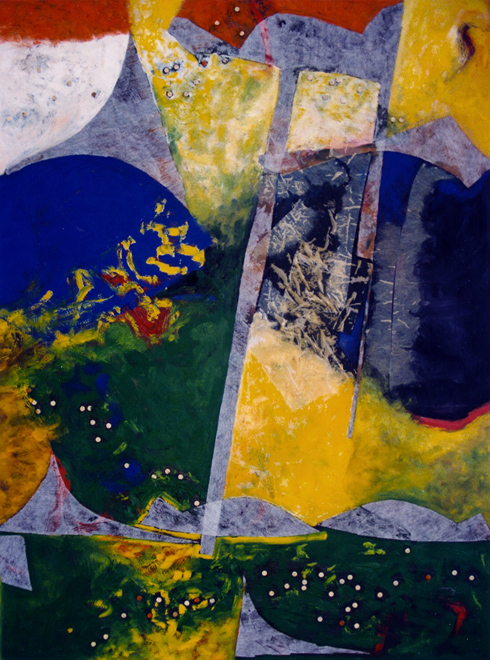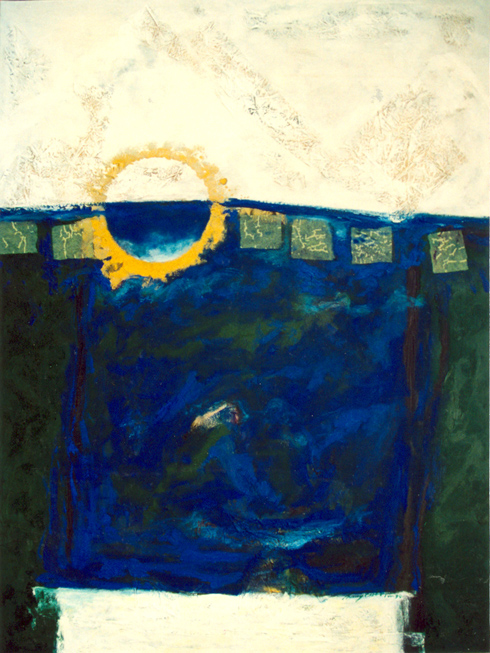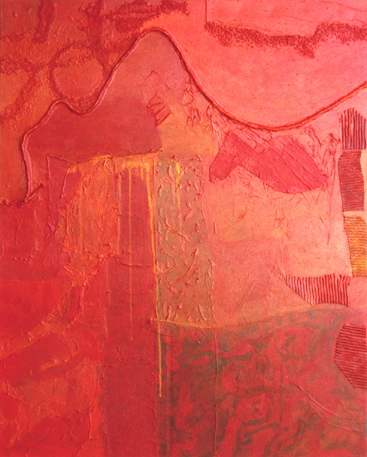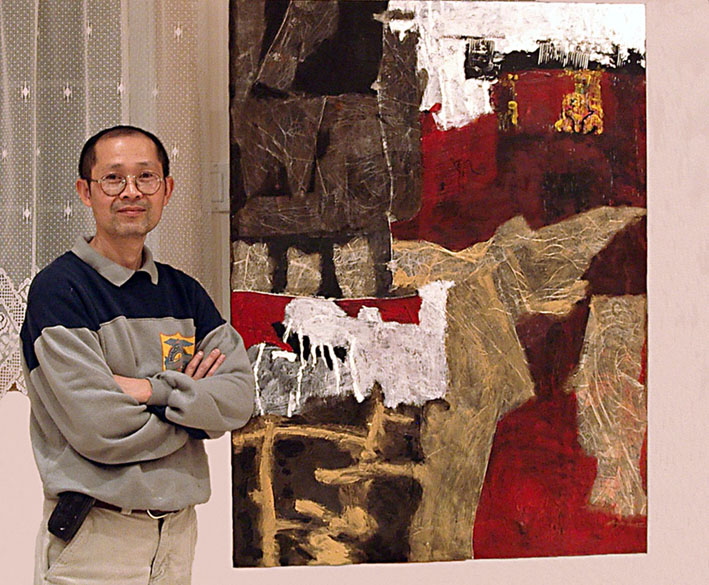Himalaya
mix media on wood panel, 24 x 48 in.
 |
The designation
‘abstract art’ is not really a style but a description.
When we say that abstract art is an art that does not attempt
to represent the appearance of any object, real or imaginary,
or that abstract painting is “an absolute entity with no
relation to objects of the visible world” we are, rightly
or wrongly, describing an impossibility. I will adduce the exemplary
abstract art of NGUYEN TAI and propose that the description and/or
definitions of abstract art exist only in theory and that art
as “an absolute entity with no relation to objects of the
visible world” is not viable.
The principles
that disclose the universals governing geometrical concepts --
which avoid all reference to the material world while proclaiming
abstraction in art free of any subjective influence and therefore
only obedient to universal laws -- were conceived in order to
position abstract art as the art of the elite. This development
served to compound the already natural impenetrability of abstract
art and subsequent attempts to define and describe it only resulted
in the further intimidation/ alienation of the viewer.
I propose
that the abstract forms that inform abstract works of art always
have their origins in the artist’s mind, and therefore refer,
consciously or unconsciously, to the known world. Even in the
most abstract of compositions there is a link to a known reality
because existential or philosophical being is always (pace Sartre)
being-in-the-world.
Composition 140
mix media on wood panel, 47 x 33 in.
 |
But
short of inviting controversy or contesting existing theories,
my objective is to describe abstract creations in such a way to
make them more accessible and to attract a wider public to a very
valid and extremely therapeutic form of artistic expression.
Abstract
art is so difficult to evaluate because there is nothing concrete
which would allow us to measure whether or not the artist has
succeeded or not in capturing or representing the essence of what
the artist may have had in mind. Naturally, he/she, the artist
must rely on composition, colour and execution but, for the average
viewer, these criteria are not sufficiently developed to rescue
him from his gut response: the viewer is left puzzled and frustrated
before a work whose greatness escapes him. So how is the viewer
to separate good from a bad art? At the individual level, it may
be the observer’s reaction to it; at the collective level,
who knows?
Abstract
art, more than figurative art, is meant to stimulate imagination
and to speak to the observer at a guttural and emotional level.
Needless to say, whether by a famous or an unknown artist or whether
abstract or figurative, a work of art that does not move the viewer
has absolutely no value.
An abstract
work is a very generous gift because the artist is permitting
the contribution of the spectator in the creative process and
there is no end to the pleasure of participating in this process.
An abstract painting is the pictorial equivalent to the tales
narrated by Scherezade in 1001 Nights. It offers a starting
point that gives the viewer the opportunity to develop the work
as he or she pleases. In fact, it is the observer who completes
the piece and has the opportunity to make an abstract work of
art a never ending story because this kind of work allows re-invention
with every new gaze. And, like the effects of listening to an
imaginative story narrated with gusto, a work of abstract art
can have an entrancing and therapeutic effect. The work of the
Canadian/Vietnamese painter NGUYEN TAI offers us this kind of
experience where the intent of his art is matched by the effects.
I spoke with TAI in his studio where he described the Buddhist
ideas behind his painting, which became the starting point of
a journey I wouldn’t have missed for anything.
No. 4
mix media on canvas, 40 x 30 in.
 |
Nguyen
Tai on Buddhism and Abstract Art As a Way of Life
Painting
is a way for me to grasp life, love and death. Just as I wish
to communicate with others, with the sky and the clouds, to
clutch a stone, to brush against the pasture, to feel the sun
and the cold on my skin; art is happiness for me.
Since
1987, my work takes Buddhist Theory as a starting point. My
paintings include several elements evoking the stability and
peace essential to meditation, such as mountains, the moon and
space.
The Moon, the Sea and the Mountain
mix media on canvas, 40 x 30 in.
 |
More
than a narrative link, the mountain is a symbol of stability
and strength representing the stable position sought by the
Buddha to meditate.
White Peak
mix media on canvas, 39 x 27 in.
 |
The
moon is symbol of peace and of serenity; it defines the conditions
necessary to meditate.
The Moon R-16
mix media on wood panel, 30 x 27 in.
 |
Lastly,
I use space so that each colour seems to defy the restrictive
framework of the canvas. This pictorial space suggests something
unlimited where the spirit wanders when it reaches the plenitude
achieved through meditation.
Trang Chin-Tu
oil on canvas, 20 x 26 in.
 |
For
me, to paint is to contemplate – nature, for example.
The materials used for my collages, whether silk paper, sand
or steel wool, do not intend to evoke nature but to form an
integral part of this nature, which is more than just the image.
Composition 143
mix media on canvas, 40 x 32 in.
 |
Though
each canvas may conceal one or more stories, I do not aspire
to narrate these stories; rather, I aspire to relieve the spirit
of distressed people through the peace and serenity emanating
from my works, as a monk does through prayer.
The Artist Nguyen Tai
 |
Nguyen
Tai is on permanent exhibition at La Galeria, 1618 Sherbrooke
St. W., Montreal (514) 932-7585. To contact the artist, please
contact Arts Editor Marissa Consiglieri de Chackal at
arts@artsandopinion.com.